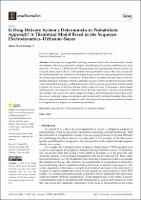Is Drug Delivery System a Deterministic or Probabilistic Approach? A Theoretical Model Based on the Sequence: Electrodynamics–Diffusion–Bayes
Publisher
MDPI
Journal
Mathematics
Abstract
Commonly, it is accepted that oncology treatment would yield outcomes with a certain determinism without any quantitative support or mathematical model that establishes such deter minations. Nowadays, with the advent of nanomedicine, the targeting drug delivery scheme has emerged, whose central objective is the uptake of nanoparticles by tumors. Once they are injected into the bloodstream, it is unclear as to which process governs the directing of nanoparticles towards the desired target, deterministic or stochastic. In any scenario, an optimal outcome, small toxicity and minimal dispersion of drugs is expected. Commonly, it is expected that an important fraction of them can be internalized into tumor. In this manner, due to the fraction of nanoparticles that have failed to uptake, the success of the drug delivery scheme might be at risk. In this paper, a theory based on the sequence electrodynamics–diffusion–Bayes theorem is presented. The Bayesian probability that emerges at the end of the sequence might be telling us that dynamical processes based on the injection of electrically charged nanoparticles might be dictated by stochastic formalism. Thus, rather than expecting a deterministic process, the chain of events would convert the drug delivery scheme to be dependent on a sequence of conditional probabilities.
Type
info:eu-repo/semantics/article
Rights
info:eu-repo/semantics/openAccess
Language
spa
Collections
- Ingeniería de Sistemas [332]


